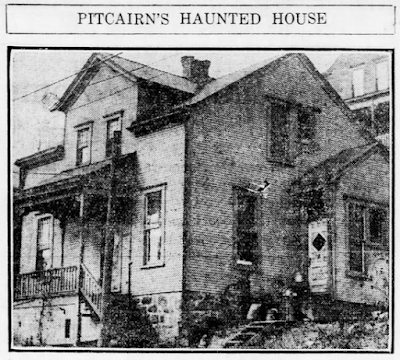The Poltergeists of Pitcairn
Fifteen miles west of Pittsburgh lies the borough of Pitcairn, once home to a major switching yard of the Pennsylvania Railroad. Pitcairn is still a railroad town, although the old Pitcairn Yard, which dates back to 1892, is now property of the Norfolk Southern Railway. The borough is also home to the very first Fox's Pizza Den location, which still stands on Broadway after more than forty years of continuous operation. Today, the chain boasts over 250 locations in 28 states.
In October of 1912, East Broadway in Pitcairn was also the home of troublesome poltergeists who not only frightened away an entire family who lived in the house, but also led to the discovery of a perplexing murder mystery-- one that remains unsolved to this day.
On the night of Monday, October 28, the families of George and William Rainey left their large, yellow house on Broadway and vowed never to return, even though they had moved in only a week earlier. The trouble began shortly after their arrival, when strange things began to happen: items around the house seemed to move by an unseen hand, doors and windows began to open and close without any human assistance, and a chilly, peculiar presence seemed to linger in the air.
But, on Monday night, things got so out of hand that the family had no choice but to abandon the house. A few hours earlier, a teakettle in the kitchen decided to levitate under its own power. The Raineys watched in disbelief as the kettle then sailed through the air, eventually colliding with Mr. Rainey's derby hat, which had floated in from the hallway. But any possibility of a prank was dispelled a few moments later, when a 150-pound sofa began to float off the ground and take off, eventually coming to rest on top of the dining room table. The Raineys fled so suddenly that they didn't even have time to gather up their possessions.
The following morning Mrs. Rainey, accompanied by several skeptical friends, worked up the nerve to return to the house in order to gather up some of her possessions. With daylight streaming through the windows and the house packed with witnesses, she was confident that the poltergeists would cease to manifest themselves-- but Mrs. Rainey was wrong.
Before the eyes of the startled guests, doors that had been shut flew open all by themselves, and doors and windows that had been locked came unlocked. Two of the women who were in attendance claim that they were put into a mysterious trance, which lasted a full twenty minutes.
 |
| The haunted house as it appears today |
Curiosity seekers thronged to the house once word of the paranormal activity spread throughout Pitcairn, necessitating a police officer to be placed on guard duty. For two days the policeman watched over the now-abandoned home, and later claimed to have had his own bizarre experiences on the property.
One of the curious locals who had an opportunity to check out the house was Dr. M.M. Thompson, a respected citizen active in Pitcairn politics. Thompson, who considered himself an educated and scientific man, obtained permission from the Rainey family to have a look around. While searching the cellar for clues, he made a chilling discovery: a baseball bat wrapped with a blood-stained skirt.
Dr. Thompson turned over his gruesome find to Chief Morehead, who now had a murder mystery on his hands. Unfortunately, the bloody garment and the presumable murder weapon were the only clues the police had to go on, and after all leads turned cold, the authorities had no choice but to close the case.
But is there more to the story than meets the eye?
In late September, just a few weeks before the Rainey families moved to Pitcairn, newspapers across the country ran headlines about a sensational murder in Wellington, Kansas. A mechanic named Theodore McKnelly, along with his wife and daughter, were brutally murdered in their tent during a camping trip, their heads bashed to a pulp. The murder weapon found at the scene was a bloody baseball bat.
Could it be possible that the skeptical Dr. Thompson, who might have been following the story out of Kansas, planted the "evidence" in the cellar out of his disdain for the silly superstitions of the locals? After all, he did explore the house alone and, being a doctor, probably had access to blood (animal or otherwise). Or were the Gaineys part of some spectacular, elaborate hoax? In any case, the truth will probably never be known.
Sources:
Pittsburgh Daily Post, Oct. 30, 1912.
Pittsburgh Daily Post, Nov. 1, 1912.
Did you enjoy this article? If so, then pick up a paperback copy of Pennsylvania Oddities, which features even more true stories of the strange from around the Keystone State, as well as more in-depth versions of some of the more spectacular stories shown on this blog. Only $14.95 and free shipping is available!




Pitcairn is 15 miles east of the 'burgh ;)
ReplyDeleteDoes someone live in that house today?
ReplyDelete